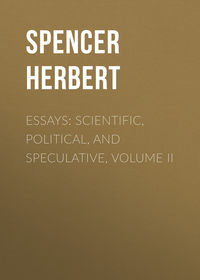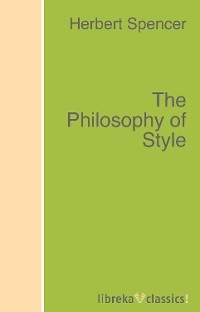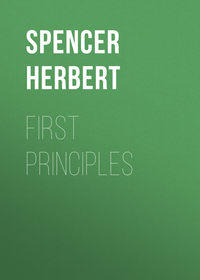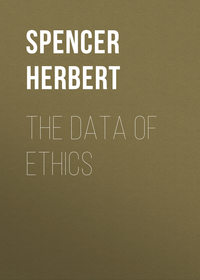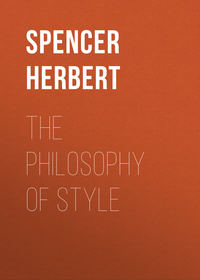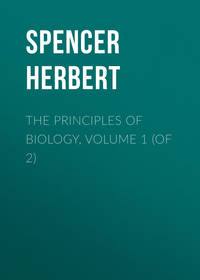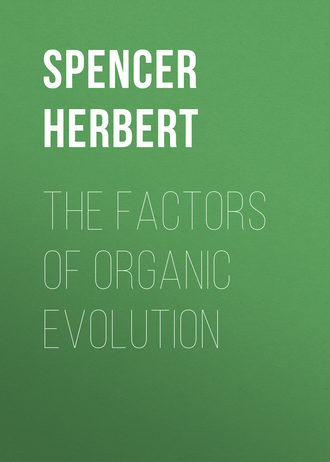 полная версия
полная версияThe Factors of Organic Evolution
Be this or be it not a warrantable conclusion, there is, I think, good reason for a provisional acceptance of the hypothesis that the effects of use and disuse are inheritable; and for a methodic pursuit of inquiries with the view of either establishing it or disproving it. It seems scarcely reasonable to accept without clear demonstration, the belief that while a trivial difference of structure arising spontaneously is transmissible, a massive difference of structure, maintained generation after generation by change of function, leaves no trace in posterity. Considering that unquestionably the modification of structure by function is a vera causa, in so far as concerns the individual; and considering the number of facts which so competent an observer as Mr. Darwin regarded as evidence that transmission of such modifications takes place in particular cases; the hypothesis that such transmission takes place in conformity with a general law, holding of all active structures, should, I think, be regarded as at least a good working hypothesis.
But now supposing the broad conclusion above drawn to be granted – supposing all to agree that from the beginning, along with inheritance of useful variations fortuitously arising, there has been inheritance of effects produced by use and disuse; do there remain no classes of organic phenomena unaccounted for? To this question I think it must be replied that there do remain classes of organic phenomena unaccounted for. It may, I believe, be shown that certain cardinal traits of animals and plants at large are still unexplained; and that a further factor must be recognized. To show this, however, will require another paper.
II
Ask a plumber who is repairing your pump, how the water is raised in it, and he replies – “By suction.” Recalling the ability which he has to suck up water into his mouth through a tube, he is certain that he understands the pump's action. To inquire what he means by suction, seems to him absurd. He says you know as well as he does, what he means; and he cannot see that there is any need for asking how it happens that the water rises in the tube when he strains his mouth in a particular way. To the question why the pump, acting by suction, will not make the water rise above 32 feet, and practically not so much, he can give no answer; but this does not shake his confidence in his explanation.
On the other hand an inquirer who insists on knowing what suction is, may obtain from the physicist answers which give him clear ideas, not only about it but about many other things. He learns that on ourselves and all things around, there is an atmospheric pressure amounting to about 15 pounds on the square inch: 15 pounds being the average weight of a column of air having a square inch for its base and extending upwards from the sea-level to the limit of the Earth's atmosphere. He is made to observe that when he puts one end of a tube into water and the other end into his mouth, and then draws back his tongue, so leaving a vacant space, two things happen. One is that the pressure of air outside his cheeks, no longer balanced by an equal pressure of air inside, thrusts his cheeks inwards; and the other is that the pressure of air on the surface of the water, no longer balanced by an equal pressure of air within the tube and his mouth (into which part of the air from the tube has gone) the water is forced up the tube in consequence of the unequal pressure. Once understanding thus the nature of the so-called suction, he sees how it happens that when the plunger of the pump is raised and relieves from atmospheric pressure the water below it, the atmospheric pressure on the water in the well, not being balanced by that on the water in the tube, forces the water higher up the tube, so that it follows the plunger. And now he sees why the water cannot be raised beyond the theoretic limit of 32 feet: a limit made much lower in practice by imperfections in the apparatus. For if, simplifying the conception, he supposes the tube of the pump to be a square inch in section, then the atmospheric pressure of 15 pounds per square inch on the water in the well, can raise the water in the tube to such height only that the entire column of it weighs 15 pounds. Having been thus enlightened about the pump's action, the action of a barometer becomes intelligible. He perceives how, under the conditions established, the weight of the column of mercury balances that of an atmospheric column of equal diameter; and how, as the weight of the atmospheric column varies, there is a corresponding variation in the weight of the mercurial column, – shown by change of height. Moreover, having previously supposed that he understood the ascent of a balloon when he ascribed it to relative lightness, he now sees that he did not truly understand it. For he did not recognize it as a result of that upward pressure caused by the difference between the weight of the mass formed by the gas in the balloon plus the cylindrical column of air extending above it to the limit of the atmosphere, and the weight of a similar cylindrical column of air extending down to the under surface of the balloon: this difference of weight causing an equivalent upward pressure on the under surface.
Why do I introduce these familiar truths so entirely irrelevant to my subject? I do it to show, in the first place, the contrast between a vague conception of a cause and a distinct conception of it; or rather, the contrast between that conception of a cause which results when it is simply classed with some other or others which familiarity makes us think we understand, and that conception of a cause which results when it is represented in terms of definite physical forces admitting of measurement. And I do it to show, in the second place, that when we insist on resolving a verbally-intelligible cause into its actual factors, we get not only a clear solution of the problem before us, but we find that the way is opened to solutions of sundry other problems. While we rest satisfied with unanalyzed causes, we may be sure both that we do not rightly comprehend the production of the particular effects ascribed to them, and that we overlook other effects which would be revealed to us by contemplation of the causes as analyzed. Especially must this be so where the causation is complex. Hence we may infer that the phenomena presented by the development of species, are not likely to be truly conceived unless we keep in view the concrete agencies at work. Let us look closely at the facts to be dealt with.
The growth of a thing is effected by the joint operation of certain forces on certain materials; and when it dwindles, there is either a lack of some materials, or the forces co-operate in a way different from that which produces growth. If a structure has varied, the implication is that the processes which built it up were made unlike the parallel processes in other cases, by the greater or less amount of some one or more of the matters or actions concerned. Where there is unusual fertility, the play of vital activities is thereby shown to have deviated from the ordinary play of vital activities; and conversely, if there is infertility. If the germs, or ova, or seed, or offspring partially developed, survive more or survive less, it is either because their molar or molecular structures are unlike the average ones, or because they are affected in unlike ways by surrounding agencies. When life is prolonged, the fact implies that the combination of actions, visible and invisible, constituting life, retains its equilibrium longer than usual in presence of environing forces which tend to destroy its equilibrium. That is to say, growth, variation, survival, death, if they are to be reduced to the forms in which physical science can recognize them, must be expressed as effects of agencies definitely conceived – mechanical forces, light, heat, chemical affinity, &c.
This general conclusion brings with it the thought that the phrases employed in discussing organic evolution, though convenient and indeed needful, are liable to mislead us by veiling the actual agencies. That which really goes on in every organism is the working together of component parts in ways conducing to the continuance of their combined actions, in presence of things and actions outside; some of which tend to subserve, and others to destroy, the combination. The matters and forces in these two groups, are the sole causes properly so called. The words “natural selection,” do not express a cause in the physical sense. They express a mode of co-operation among causes – or rather, to speak strictly, they express an effect of this mode of co-operation. The idea they convey seems perfectly intelligible. Natural selection having been compared with artificial selection, and the analogy pointed out, there apparently remains no indefiniteness: the inconvenience being, however, that the definiteness is of a wrong kind. The tacitly implied Nature which selects, is not an embodied agency analogous to the man who selects artificially; and the selection is not the picking out of an individual fixed on, but the overthrowing of many individuals by agencies which one successfully resists, and hence continues to live and multiply. Mr. Darwin was conscious of these misleading implications. In the introduction to his Animals and Plants under Domestication (p. 6) he says: —
“For brevity sake I sometimes speak of natural selection as an intelligent power; … I have, also, often personified the word Nature; for I have found it difficult to avoid this ambiguity; but I mean by nature only the aggregate action and product of many natural laws, – and by laws only the ascertained sequence of events.”
But while he thus clearly saw, and distinctly asserted, that the factors of organic evolution are the concrete actions, inner and outer, to which every organism is subject, Mr. Darwin, by habitually using the convenient figure of speech, was, I think, prevented from recognizing so fully as he would otherwise have done, certain fundamental consequences of these actions.
Though it does not personalize the cause, and does not assimilate its mode of working to a human mode of working, kindred objections may be urged against the expression to which I was led when seeking to present the phenomena in literal terms rather than metaphorical terms – the survival of the fittest;2 for in a vague way the first word, and in a clear way the second word, calls up an anthropocentric idea. The thought of survival inevitably suggests the human view of certain sets of phenomena, rather than that character which they have simply as groups of changes. If, asking what we really know of a plant, we exclude all the ideas associated with the words life and death, we find that the sole facts known to us are that there go on in the plant certain inter-dependent processes, in presence of certain aiding and hindering influences outside of it; and that in some cases a difference of structure or a favourable set of circumstances, allows these inter-dependent processes to go on for longer periods than in other cases. Again, in the working together of those many actions, internal and external, which determine the lives or deaths of organisms, we see nothing to which the words fitness and unfitness are applicable in the physical sense. If a key fits a lock, or a glove a hand, the relation of the things to one another is presentable to the perceptions. No approach to fitness of this kind is made by an organism which continues to live under certain conditions. Neither the organic structures themselves, nor their individual movements, nor those combined movements of certain among them which constitute conduct, are related in any analogous way to the things and actions in the environment. Evidently the word fittest, as thus used, is a figure of speech; suggesting the fact that amid surrounding actions, an organism characterized by the word has either a greater ability than others of its kind to maintain the equilibrium of its vital activities, or else has so much greater a power of multiplication that though not longer lived than they, it continues to live in posterity more persistently. And indeed, as we here see, the word fittest has to cover cases in which there may be less ability than usual to survive individually, but in which the defect is more than made good by higher degrees of fertility.
I have elaborated this criticism with the intention of emphasizing the need for studying the changes which have gone on, and are ever going on, in organic bodies, from an exclusively physical point of view. On contemplating the facts from this point of view, we become aware that, besides those special effects of the co-operating forces which eventuate in the longer survival of one individual than of others, and in the consequent increase through generations, of some trait which furthered its survival, many other effects are being wrought on each and all of the individuals. Bodies of every class and quality, inorganic as well as organic, are from instant to instant subject to the influences in their environments; are from instant to instant being changed by these in ways that are mostly inconspicuous; and are in course of time changed by them in conspicuous ways. Living things in common with dead things, are, I say, being thus perpetually acted upon and modified; and the changes hence resulting, constitute an all-important part of those undergone in the course of organic evolution. I do not mean to imply that changes of this class pass entirely unrecognized; for, as we shall see, Mr. Darwin takes cognizance of certain secondary and special ones. But the effects which are not taken into account, are those primary and universal effects which give certain fundamental characters to all organisms. Contemplation of an analogy will best prepare the way for appreciation of them, and of the relation they bear to those which at present monopolize attention.
An observant rambler along shores, will, here and there, note places where the sea has deposited things more or less similar, and separated them from dissimilar things – will see shingle parted from sand; larger stones sorted from smaller stones; and will occasionally discover deposits of shells more or less worn by being rolled about. Sometimes the pebbles or boulders composing the shingle at one end of a bay, he will find much larger than those at the other: intermediate sizes, having small average differences, occupying the space between the extremes. An example occurs, if I remember rightly, some mile or two to the west of Tenby; but the most remarkable and well-known example is that afforded by the Chesil bank. Here, along a shore some sixteen miles long, there is a gradual increase in the sizes of the stones; which, being at one end but mere pebbles, are at the other end immense boulders. In this case, then, the breakers and the undertow have effected a selection – have at each place left behind those stones which were too large to be readily moved, while taking away others small enough to be moved easily. But now, if we contemplate exclusively this selective action of the sea, we overlook certain important effects which the sea simultaneously works. While the stones have been differently acted upon in so far that some have been left here and some carried there; they have been similarly acted upon in two allied, but distinguishable, ways. By perpetually rolling them about and knocking them one against another, the waves have so broken off their most prominent parts as to produce in all of them more or less rounded forms; and then, further, the mutual friction of the stones simultaneously caused, has smoothed their surfaces. That is to say in general terms, the actions of environing agencies, so far as they have operated indiscriminately, have produced in the stones a certain unity of character; at the same time that they have, by their differential effects, separated them: the larger ones having withstood certain violent actions which the smaller ones could not withstand.
Similarly with other assemblages of objects which are alike in their primary traits but unlike in their secondary traits. When simultaneously exposed to the same set of actions, some of these actions, rising to a certain intensity, may be expected to work on particular members of the assemblage changes which they cannot work in those which are markedly unlike; while others of the actions will work in all of them similar changes, because of the uniform relations between these actions and certain attributes common to all members of the assemblage. Hence it is inferable that on living organisms, which form an assemblage of this kind, and are unceasingly exposed in common to the agencies composing their inorganic environments, there must be wrought two such sets of effects. There will result a universal likeness among them consequent on the likeness of their respective relations to the matters and forces around; and there will result, in some cases, the differences due to the differential effects of these matters and forces, and in other cases, the changes which, being life-sustaining or life-destroying, eventuate in certain natural selections.
I have, above, made a passing reference to the fact that Mr. Darwin did not fail to take account of some among these effects directly produced on organisms by surrounding inorganic agencies. Here are extracts from the sixth edition of the Origin of Species showing this.
“It is very difficult to decide how far changed conditions, such as of climate, food, &c., have acted in a definite manner. There is reason to believe that in the course of time the effects have been greater than can be proved by clear evidence… Mr. Gould believes that birds of the same species are more brightly coloured under a clear atmosphere, than when living near the coast or on islands; and Wollaston is convinced that residence near the sea affects the colours of insects. Moquin-Tandon gives a list of plants which, when growing near the sea-shore, have their leaves in some degree fleshy, though not elsewhere fleshy” (pp. 106-7). “Some observers are convinced that a damp climate affects the growth of the hair, and that with the hair the horns are correlated” (p. 159).
In his subsequent work, Animals and Plants under Domestication, Mr. Darwin still more clearly recognizes these causes of change in organization. A chapter is devoted to the subject. After premising that “the direct action of the conditions of life, whether leading to definite or indefinite results, is a totally distinct consideration from the effects of natural selection;” he goes on to say that changed conditions of life “have acted so definitely and powerfully on the organisation of our domesticated productions, that they have sufficed to form new sub-varieties or races, without the aid of selection by man or of natural selection.” Of his examples here are two.
“I have given in detail in the ninth chapter the most remarkable case known to me, namely, that in Germany several varieties of maize brought from the hotter parts of America were transformed in the course of only two or three generations.” (Vol. ii, p. 277.) [And in this ninth chapter concerning these and other such instances he says “some of the foregoing differences would certainly be considered of specific value with plants in a state of nature.” (Vol. i, p. 321.)] “Mr. Meehan, in a remarkable paper, compares twenty-nine kinds of American trees, belonging to various orders, with their nearest European allies, all grown in close proximity in the same garden and under as nearly as possible the same conditions.” And then enumerating six traits in which the American forms all of them differ in like ways from their allied European forms, Mr. Darwin thinks there is no choice but to conclude that these “have been definitely caused by the long-continued action of the different climate of the two continents on the trees.” (Vol. ii, pp. 281-2.)
But the fact we have to note is that while Mr. Darwin thus took account of special effects due to special amounts and combinations of agencies in the environment, he did not take account of the far more important effects due to the general and constant operation of these agencies.3 If a difference between the quantities of a force which acts on two organisms, otherwise alike and otherwise similarly conditioned, produces some difference between them; then, by implication, this force produces in both of them effects which they show in common. The inequality between two things cannot have a value unless the things themselves have values. Similarly if, in two cases, some unlikeness of proportion among the surrounding inorganic agencies to which two plants or two animals are exposed, is followed by some unlikeness in the changes wrought on them; then it follows that these several agencies taken separately, work changes in both of them. Hence we must infer that organisms have certain structural characters in common, which are consequent on the action of the medium in which they exist: using the word medium in a comprehensive sense, as including all physical forces falling upon them as well as matters bathing them. And we may conclude that from the primary characters thus produced there must result secondary characters.
Before going on to observe those general traits of organisms due to the general action of the inorganic environment upon them, I feel tempted to enlarge on the effects produced by each of the several matters and forces constituting the environment. I should like to do this not only to give a clear preliminary conception of the ways in which all organisms are affected by these universally-present agents, but also to show that, in the first place, these agents modify inorganic bodies as well as organic bodies, and that, in the second place, the organic are far more modifiable by them than the inorganic. But to avoid undue suspension of the argument, I content myself with saying that when the respective effects of gravitation, heat, light, &c, are studied, as well as the respective effects, physical and chemical, of the matters forming the media, water and air, it will be found that while more or less operative on all bodies, each modifies organic bodies to an extent immensely greater than the extent to which it modifies inorganic bodies.
Here, not discriminating among the special effects which these various forces and matters in the environment produce on both classes of bodies, let us consider their combined effects, and ask – What is the most general trait of such effects?
Obviously the most general trait is the greater amount of change wrought on the outer surface than on the inner mass. In so far as the matters of which the medium is composed come into play, the unavoidable implication is that they act more on the parts directly exposed to them than on the parts sheltered from them. And in so far as the forces pervading the medium come into play, it is manifest that, excluding gravity, which affects outer and inner parts indiscriminately, the outer parts have to bear larger shares of their actions. If it is a question of heat, then the exterior must lose it or gain it faster than the interior; and in a medium which is now warmer and now colder, the two must habitually differ in temperature to some extent – at least where the size is considerable. If it is a question of light, then in all but absolutely transparent masses, the outer parts must undergo more of any change producible by it than the inner parts – supposing other things equal; by which I mean, supposing the case is not complicated by any such convexities of the outer surface as produce internal concentrations of rays. Hence then, speaking generally, the necessity is that the primary and almost universal effect of the converse between the body and its medium, is to differentiate its outside from its inside. I say almost universal, because where the body is both mechanically and chemically stable, like, for instance, a quartz crystal, the medium may fail to work either inner or outer change.
Of illustrations among inorganic bodies, a convenient one is supplied by an old cannon-ball that has been long lying exposed. A coating of rust, formed of flakes within flakes, incloses it; and this thickens year by year, until, perhaps, it reaches a stage at which its exterior loses as much by rain and wind as its interior gains by further oxidation of the iron. Most mineral masses – pebbles, boulders, rocks – if they show any effect of the environment at all, show it only by that disintegration of surface which follows the freezing of absorbed water: an effect which, though mechanical rather than chemical, equally illustrates the general truth. Occasionally a “rocking-stone” is thus produced. There are formed successive layers relatively friable in texture, each of which, thickest at the most exposed parts, and being presently lost by weathering, leaves the contained mass in a shape more rounded than before; until, resting on its convex under-surface, it is easily moved. But of all instances perhaps the most remarkable is one to be seen on the west bank of the Nile at Philæ, where a ridge of granite 100 feet high, has had its outer parts reduced in course of time to a collection of boulder-shaped masses, varying from say a yard in diameter to six or eight feet, each one of which shows in progress an exfoliation of successively-formed shells of decomposed granite: most of the masses having portions of such shells partially detached.


